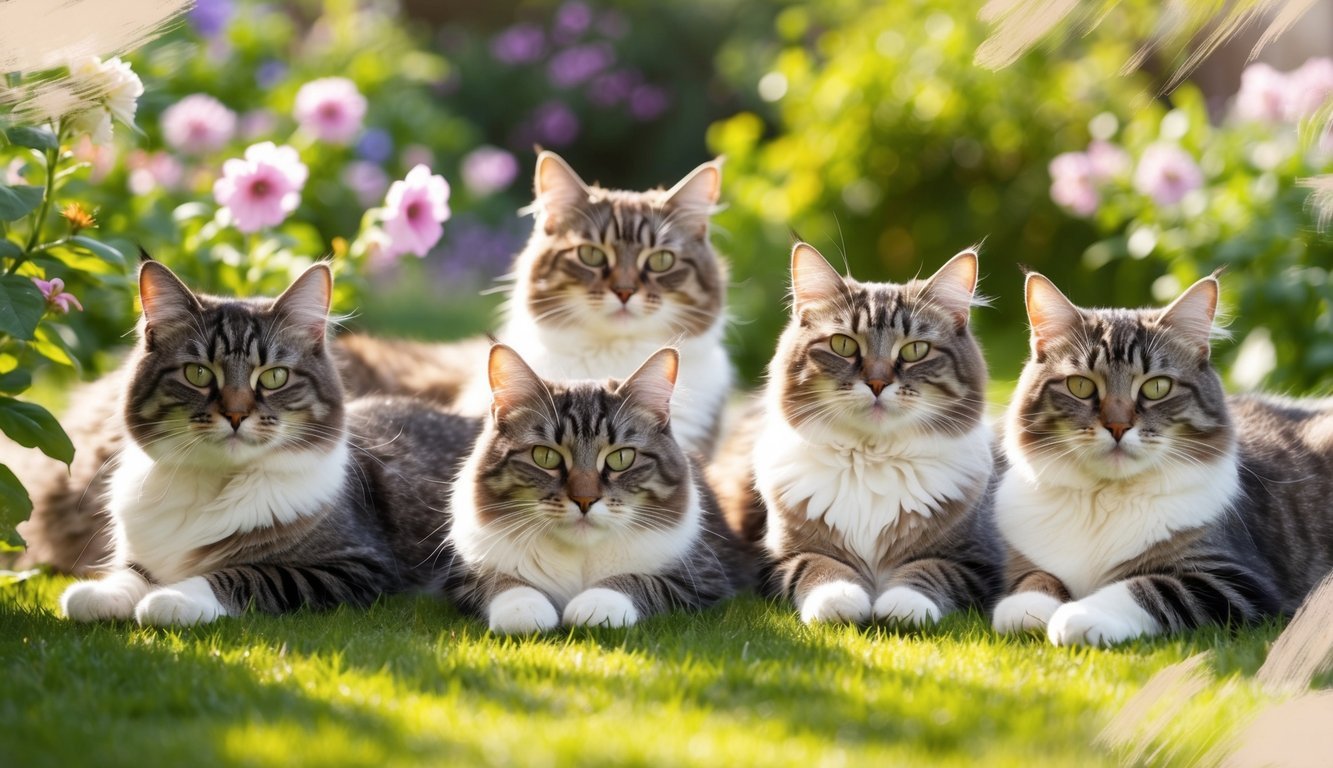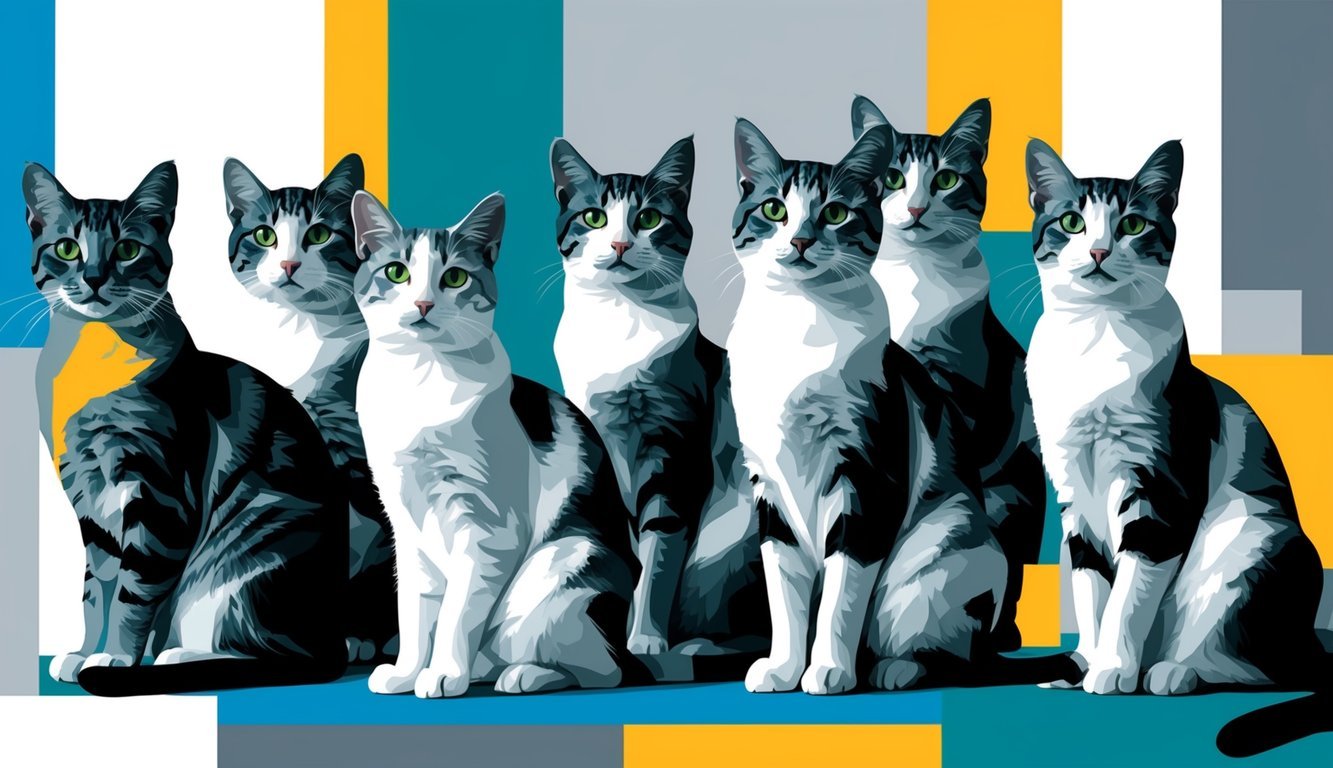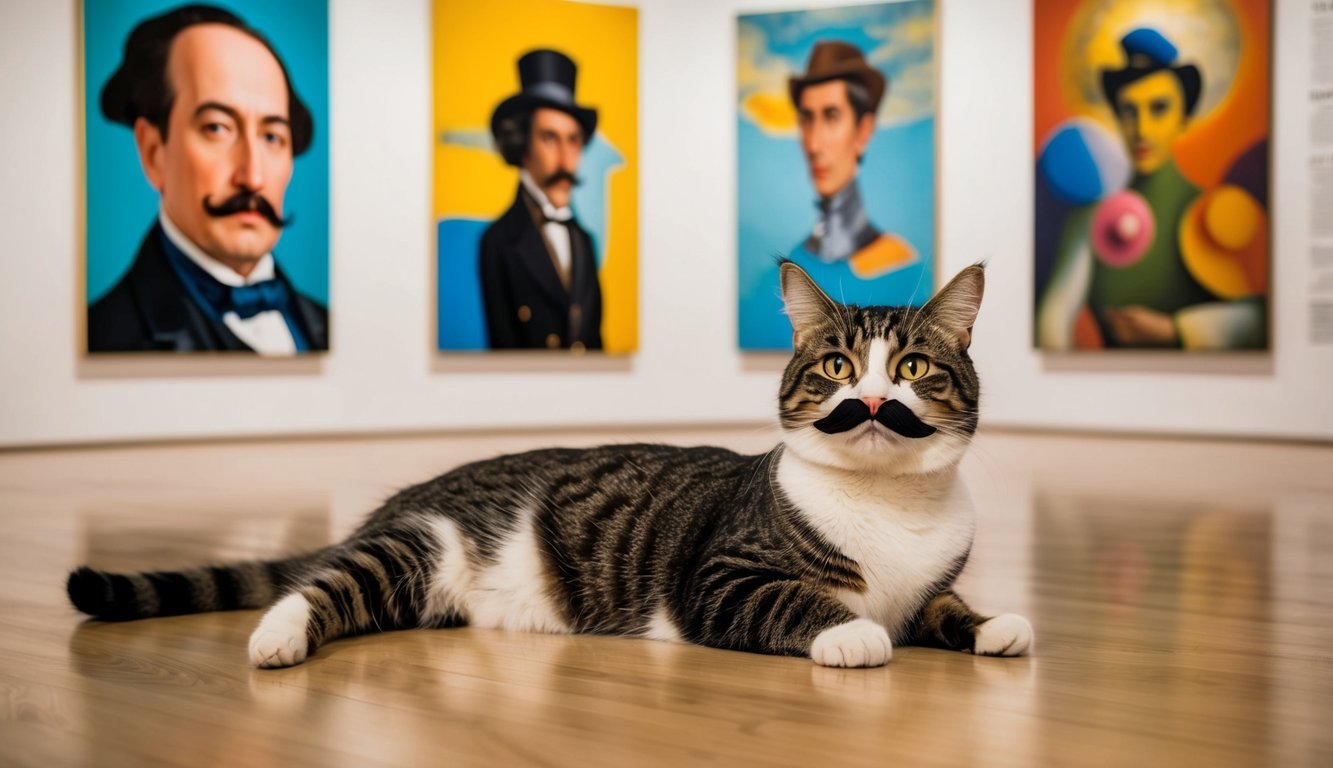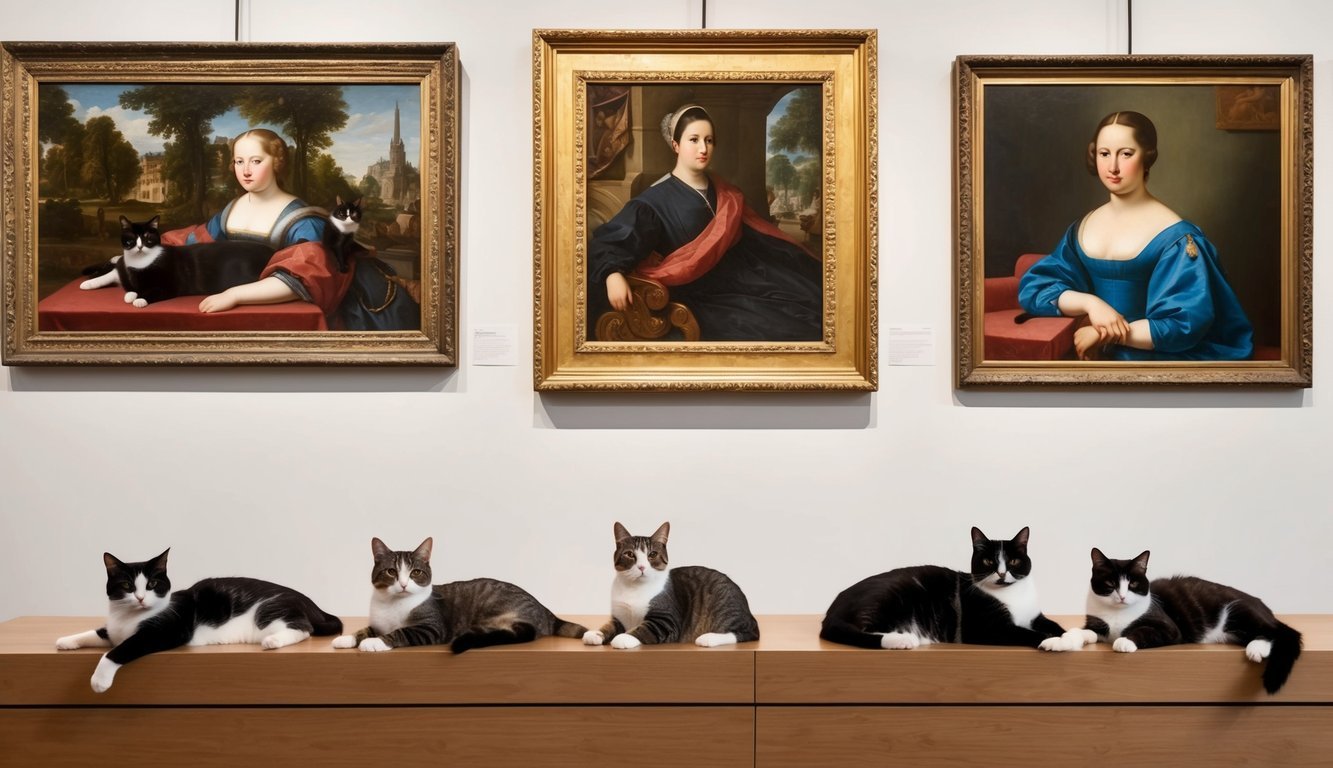PsychNewsDaily Publishers
100 Summit Drive
Burlington, MA, 01803
Telephone: (320) 349-2484
PsychNewsDaily Publishers
100 Summit Drive
Burlington, MA, 01803
Telephone: (320) 349-2484
Cats have been significant in art since ancient Egypt, symbolizing divinity and companionship, inspiring artists like Renoir, Picasso, and Marc throughout history.

When I think about where cats first showed up in art, my mind always goes to ancient Egypt. Those folks really loved their feline friends! Cats were basically gods there, especially the goddess Bastet who had a cat’s head.
Egyptian art is full of cat images – on tomb walls, statues, and jewelry. I’ve always been fascinated by how they captured the grace and mystery of cats thousands of years ago. Classical cats were viewed very differently than our cuddly companions today.
The relationship between humans and cats has deep roots in art history. We’ve been painting these critters since the begining of civilization!
In Japan, artists like Utagawa Kuniyoshi and Hiroshige II created amazing woodblock prints featuring cats in the 1800s. These weren’t just pet portraits – they showed cats doing human things or being mischevious. I wonder if those artists had cats of their own?
The development of realism in art brought new ways to show cats. Artists started painting them more naturally, capturing their true behaviors rather than just using them as symbols.
Cat companionship became a popular subject as society changed. In the 19th century, iconic paintings began featuring cats that carried both symbolic meaning and realistic presence.

Impressionist painters had this amazing way of capturing our feline friends with their loose brushstrokes and brilliant colors. They really knew how to show cats as both elegant companions and symbols of modern life.
When I look at Pierre-Auguste Renoir’s paintings featuring cats, I’m always struck by how he made their fur seem to glow. He used these tiny brushstrokes that somehow captured both the texture and the way light plays across a cat’s body. It’s honestly magical! One of his works shows a white cat that’s just bathed in warm light – you can almost feel the softness.
Édouard Manet took a different approach that I find super interesting. His painting with the black cat became pretty famous, and I can see why! The way he handled paint gave this amazing textural quality to the fur. Manet often placed cats in modern settings, making them symbols of the changing urban lifestyle.
I wonder if these artists knew they were creating such timeless images? Their cats weren’t just pets but represented something deeper about domesticity and comfort in a rapidly changing world.
Berthe Morisot painted cats with this incredible sensitivity that I just adore. Her loose, feathery brushstrokes were perfect for capturing a cat’s whiskers and the soft fur around their faces. She often included cats in intimate domestic scenes, giving us this glimpse into quiet moments of nineteenth-century life.
Mary Cassatt, though better known for her paintings of mothers and children, also created some wonderful cat portraits. What strikes me about her work is how she captured the independence in a cat’s posture – those alert ears and pricked whiskers that show a cat’s attentiveness.
Suzanne Valadon, who started as a model before becoming an artist herself, brought a fresh perspective to cat paintings. She wasn’t afraid to show cats being, well, cats – stretching, grooming, or just being their mysterious selves. Her work feels so honest to me, like she really understood these animals.

Cats seem to have a special place in cubist art, where they’re transformed into something new yet recognizable. I’ve always been fascinated by how Picasso and other cubists saw our feline friends through their unique artistic vision.
Picasso’s relationship with cats in his artwork reflects his overall artistic journey. In “The Cat’s Lunch” (1912), I notice how he breaks down the cat into geometric shapes while still capturing its essential catness. The way he fragments the form reminds me of looking through a broken mirror – you still see the cat, but in a totally new way.
When Picasso painted Cat Catching a Bird in 1939, he was showing us something primal. The cat isn’t just a cute pet anymore. It’s a hunter with sharp angles and distorted features. I think Picasso wanted us to feel uncomfortable, ya know? He strips away the cuteness and shows the cat’s true nature.
His cats aren’t meant to be pretty. They’re meant to make us think about what a cat really is beyond what we normally see. Cubism lets us see the cat from multiple angles at once, and honestly, it makes me think about how complex even simple creatures can be.
While not a cubist, I’ve always felt Leonardo da Vinci’s approach to cats offers an interesting contrast to Picasso’s interpretations. Leonardo’s detailed studies of cats reflect his scientific mind. In his notebooks, he captured cats in motion, studying their muscles and movements with incredible accuracy.
Leonardo once wrote that “the smallest feline is a masterpiece,” and his drawings prove he believed this. I’m particularly drawn to how he would sketch cats in various positions – sleeping, pouncing, grooming – trying to understand their perfect natural design.
Unlike Picasso who fragmented his subjects, Leonardo sought to understand cats through careful observation. His approach was more about revealing truth through detailed study rather than through conceptual transformation. When I look at Leonardo’s cat studies, I feel like I’m seeing the template that later artists like Picasso would deconstruct.

Cats have been purring their way through the artistic movement of Surrealism and right into today’s contemporary art scene. The feline form has been twisted, reimagined, and celebrated as artists broke free from traditional representations to explore deeper meanings and new visual languages.
Marc Chagall, gosh, he’s one of my absolute favorites when it comes to dreamlike cat imagery! His floating figures and vibrant colors created a sort of magical universe where cats could defy gravity. I’ve always been struck by how he blended Jewish folklore with modern art techniques, giving his cats an almost spiritual quality.
In works like “Cat on a Clothesline,” Chagall placed felines in impossible situations, making us wonder about the boundaries between dreams and reality. The cats in his paintings aren’t just pets – they’re magical beings that connect different worlds.
Honestly, it makes me think about how Chagall saw cats as symbols of intuition and inner wisdom. His cats have these expressive eyes that seem to know secrets about the universe that we don’t. The way he positioned them alongside human figures suggests a mysterious connection that transcends ordinary relationships.
Jeff Koons took cats in a completely different direction! His approach to feline imagery is all about shiny surfaces and pop culture references that make you do a double-take. Koons’ work kinda reminds me of how cats themselves can be both elegant and ridiculous at the same time.
Unlike the surrealists’ esoteric exploration of the subconcious, Koons brings cats into consumer culture, often creating glossy, oversized sculptures that are both familiar and strange. His cats aren’t hidden in symbolism – they’re right in your face, challenging what we think about as “art.”
I wonder if Koons is actually commenting on how we’ve commercialized everything, even our relationship with animals? His work sits in this weird space between celebration and criticism of how cats have become internet sensations and marketing tools.
What I find most interesting is how different Koons is from Théophile Steinlen’s iconic “Le Chat Noir” posters, yet they’re both responding to the popular culture of their times, just separated by about a hundred years of art history.

Cats have prowled through art history with their mysterious presence and symbolic weight. Their unique place in our cultural imagination has inspired artists to capture their essence in ways that reveal both the artists’ vision and society’s relationship with these enigmatic creatures.
Franz Marc’s famous cat paintings show a truly different approach to animals in art. He wasn’t just painting cats – he was using them to explore deeper ideas about nature and spirituality. I’m particularly drawn to his blue cats, which feel almost supernatural in their vibrant coloring.
Marc believed animals possessed a purer spirit than humans. His cats aren’t just pets; they’re mystical beings that reveal a hidden world beyond our understanding. The blue color he often used wasn’t random either – it represented masculinity and spirituality in his personal color symbolism.
What fascinates me about Marc’s work is how he captured the feline symbolism of curiosity and independence. These aren’t passive house cats – they’re powerful, sentient creatures with their own inner lives. Honestly, it makes me think about how we often underestimate the complexity of animals that share our homes.
Louis Wain’s journey with cat art is one of the most fascinating stories in art history. Before his mental illness progressed, Wain was the founder of the National Cat Club and completely changed how Victorian society viewed cats. I wonder if people today realize how much his whimsical anthropomorphic cats influenced our modern love of cat pictures?
His most celebrated work, “The White Cat,” shows his amazing ability to capture feline personality while adding human characteristics. The white cat appears in several of his paintings, sometimes wearing clothes or engaged in human activities like drinking tea or playing golf.
As Wain’s mental health deteriorated, his cats transformed from charming companions to fractured, kaleidoscopic patterns. These later famous cat paintings have been studied by psychologists as evidence of his changing perception. What’s remarkable is that even in his illness, cats remained his constant artistic focus. We can see his whole life journey through these feline portraits, from playful beginnings to the complicated patterns of his later years.

Cats have slunk their way through art history in the most fascinating ways! Artists across different periods have captured our feline friends in various moods, settings, and symbolic poses, leaving us with tons of questions about their presence in iconic works.
You’re probably thinking of Louis Wain! This guy was absolutely obsessed with cats and painted them constantly. His early works showed realistic kitties in human situations, but as his mental health declined, his cats became more colorful and abstract.
I always find it interesting how his life story kinda shows through his cat paintings. At first they’re these proper Victorian cats, and then they transform into these psychedelic rainbow felines. It’s like watching someone’s mind unfold through cat portraits.
Cats in old paintings weren’t just cute pets – they carried tons of symbolism! In many European paintings, black cats often represented the famous painting with the black cat which symbolized promiscuity or danger.
White cats usually meant innocence or purity. And ya know what’s weird? In ancient Egyptian art, cats were basically divine! They represented the goddess Bastet and were super respected. I think it’s so cool how one animal can mean totally different things depending on when and where the painting was made.
The Picasso painting you’re thinking of is “Cat Eating a Bird” from 1939! It’s not his most famous work, but it’s definitely memorable with its sharp angles and disturbing imagery.
Picasso wasn’t actually known for painting lots of cats, but this one really stands out. It shows the cruel side of nature in his distinctive cubist style. I always find it kinda jarring how he portrayed this everyday scene in such a violent, fractured way. Makes you think about the cycle of life and all that deep stuff.
They totally did! Medieval manuscripts are full of cats doing the silliest things – chasing mice, stealing food, or just being weird cat-shaped blobs. These artists had a great sense of humor about our feline friends.
My favorite are the household scenes depicting monkeys and cats that show cats just being their curious selves. There’s even manuscripts where cats are playing musical instruments or wearing little outfits! Medieval monks must’ve had some cat companions hanging around the scriptorium for inspiration.
You’re probably thinking of Leonor Fini! She was this amazing surrealist artist who absolutely adored cats and included them in many of her dreamlike paintings. She lived with up to 17 cats at once in her Paris apartment!
Fini saw cats as magical, independent creatures and portrayed them as these mysterious guardians in her art. I love how she captured their elegance and otherworldliness. Her relationship with cats reminds me that the history of our relationship to cats has always been fascinating.
You might be thinking of Franz Marc’s “The Cat” from 1912! It’s this vibrantly colored cubist-inspired painting with these bold blue and yellow shapes forming a sleeping kitty. His style is instantly recognizable.
Another possibility could be Paul Klee’s “Cat and Bird.” It has a simple geometric cat face that somehow captures the exact expression of a cat plotting something mischievous. I’ve always thought it’s amazing how these abstract artists could reduce a cat to just a few lines and colors but still capture their essential cat-ness. Like, we immediately know it’s a cat even though it doesn’t really look like one!